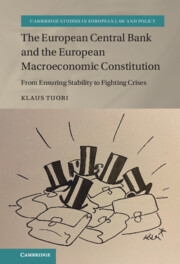 The European Central Bank and the European Macroeconomic Constitution
The European Central Bank and the European Macroeconomic Constitution from Part III - The ECB from a Central Bank of Stability to a Central Bank of Crisis
Published online by Cambridge University Press: 15 September 2022
The chapter analyses the fate of the constitutional principles of the European Macroeconomic Constitution after the recurring crises. The measures by the ECB stretched the principles to the limits and beyond. The objectives of internal market and price stability fared relatively well, but the principle of open market economy less so. However, the institutional choices and safeguards were all seriously altered, where the prohibition of central bank financing and Member States responsibility for sound fiscal policy were among the key principles that were the most fundamentally transformed. This, apart from the concerns about the constitutionality of individual measures, raises fundamental questions about the European Macroeconomic Constitution. The accountability and even legitimacy of the ECB relied on its unique position as a central bank of an economic constitution. It empowered it, gave it independence, but also constrained and controlled it. The chapter argues that the preconditions for an independent expert role of the ECB have been challenged by its measures and the inability of the judicial review to sustain sufficient boundaries. Consequently, the accountability and legitimacy of the ECB have been compromised, and with that also the rule of law with regard to the EMU is under threat.
To save this book to your Kindle, first ensure [email protected] is added to your Approved Personal Document E-mail List under your Personal Document Settings on the Manage Your Content and Devices page of your Amazon account. Then enter the ‘name’ part of your Kindle email address below. Find out more about saving to your Kindle.
Note you can select to save to either the @free.kindle.com or @kindle.com variations. ‘@free.kindle.com’ emails are free but can only be saved to your device when it is connected to wi-fi. ‘@kindle.com’ emails can be delivered even when you are not connected to wi-fi, but note that service fees apply.
Find out more about the Kindle Personal Document Service.
To save content items to your account, please confirm that you agree to abide by our usage policies. If this is the first time you use this feature, you will be asked to authorise Cambridge Core to connect with your account. Find out more about saving content to Dropbox.
To save content items to your account, please confirm that you agree to abide by our usage policies. If this is the first time you use this feature, you will be asked to authorise Cambridge Core to connect with your account. Find out more about saving content to Google Drive.